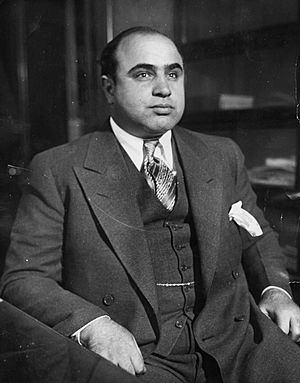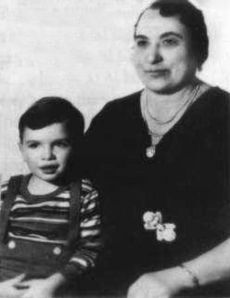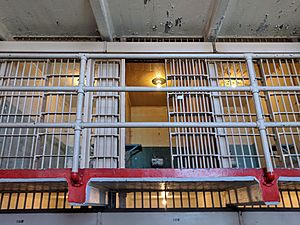Al Capone facts for kids
Quick facts for kids
Al Capone
|
|
|---|---|

Capone in 1930
|
|
| Born |
Alphonse Gabriel Capone
January 17, 1899 New York City, U.S.
|
| Died | January 25, 1947 (aged 48) Palm Island, Florida, U.S.
|
| Resting place | Mount Carmel Cemetery, Hillside, Illinois, U.S. |
| Other names |
|
| Occupation |
|
| Known for |
|
| Spouse(s) |
Mae Coughlin
(m. 1918) |
| Children | 1 |
| Relatives |
|
| Allegiance | Chicago Outfit |
| Conviction(s) | Tax evasion (26 U.S.C. § 145) (5 counts) |
| Criminal penalty | 11 years imprisonment (1931) |
| Signature | |
Alphonse Gabriel Capone (January 17, 1899 – January 25, 1947) was an American businessman. He became well-known during the Prohibition era. From 1925 to 1931, he was a leader of the Chicago Outfit. His time as a leader ended when he went to prison at age 33. He was sometimes called "Scarface".
Contents
Who Was Al Capone?
Alphonse Gabriel Capone was born in Brooklyn, New York City, on January 17, 1899. His parents, Gabriele and Teresa Capone, were immigrants from Italy. His father was a barber, and his mother was a seamstress. They came to the United States in 1893.
Capone's Family and Siblings
The Capone family first settled in the Navy Yard section of Brooklyn. Later, they moved to Park Slope, Brooklyn, when Al was 11. Al Capone had eight brothers and sisters. Some of his brothers, Ralph and Frank, also worked with him. Ralph managed Capone's legal and illegal bottling companies. Frank worked with him until his death in 1924.
Al Capone's Early Life and Education
Al Capone was a bright student. However, he found it hard to follow the rules at his strict Catholic school. His schooling ended when he was 14. He was expelled for hitting a female teacher. After leaving school, Capone worked at different odd jobs. These included a candy store and a bowling alley. From 1916 to 1918, he played semi-professional baseball. Later, he was influenced by a man named Johnny Torrio. Torrio became a mentor to him.
Capone's Rise to Influence
As a teenager, Capone joined the Five Points Gang. He worked as a bouncer in places connected to organized groups. In his early twenties, Capone moved to Chicago. There, he became a trusted helper for Johnny Torrio. Torrio led a group that illegally supplied alcohol. This group later became known as the Chicago Outfit.
Leading the Chicago Outfit
A conflict with another group, the North Side Gang, was important in Capone's story. Torrio decided to retire after almost being killed. He then gave control of the group to Capone. Capone expanded the business of illegally supplying alcohol. He used increasingly strong methods. However, he had good relationships with the mayor and the police. This made him seem safe from law enforcement.
Public Image and Legal Troubles
The Saint Valentine's Day Massacre was a terrible event. Seven rivals were killed in broad daylight. This event badly hurt Capone's public image. People in Chicago demanded action from the government. Newspapers began calling Capone "Public Enemy No. 1".
Federal authorities decided to put Capone in jail. They charged him with many counts of tax evasion. He was found guilty of five of these charges in 1931. During his trial, the judge allowed Capone's own words about his income to be used as evidence. He was found guilty and sentenced to eleven years in federal prison.
Time in Prison
Capone was sent to Atlanta U.S. Penitentiary in May 1932. He was 33 years old. In Atlanta, Capone worked stitching shoe soles. He worked for eight hours a day. However, his letters were hard to understand. He seemed weak and struggled with bullying from other prisoners. His cellmate, Morris Rudensky, even worried Capone might have a breakdown.
Moving to Alcatraz
Rudensky, a former small-time criminal, protected Capone. This protection made other inmates suspicious. They thought Capone was getting special treatment. No strong proof ever appeared. However, it was part of the reason Capone was moved. In August 1934, he was sent to the new Alcatraz Federal Penitentiary. This prison was off the coast of San Francisco.
Life and Health in Alcatraz
At Alcatraz, Capone's health got worse. His mental abilities slowly declined. In February 1938, he was formally diagnosed with a serious illness. He spent his last year at Alcatraz in the hospital section. He was often confused and disoriented. Capone finished his sentence at Alcatraz on January 6, 1939. He was then moved to another prison in California. He was released on November 16, 1939. His wife, Mae, had asked the court for his release. This was because of his reduced mental state.
Later Life and Passing
Capone was released from prison due to his poor health. He was sent to Johns Hopkins Hospital in Baltimore. Because of his reputation, Johns Hopkins refused to treat him. However, Union Memorial Hospital in Baltimore did. Capone was thankful for their care. He even donated two cherry trees to the hospital in 1939.
Final Years in Florida
By March 1940, a very sick Capone left Baltimore. He traveled to his mansion in Palm Island, Florida. In 1942, penicillin became widely available. Capone was one of the first Americans treated with this new medicine. It was too late to fix the damage to his brain. But it did slow down his illness.
In 1946, doctors examined him. They concluded Capone had the mental ability of a 12-year-old child. He spent his last years at his Florida mansion. He spent time with his wife and grandchildren.
Al Capone's Death
On January 21, 1947, Capone had a stroke. He woke up and started to get better. But then he got bronchopneumonia. He had a cardiac arrest on January 22. On January 25, he died at home with his family. His heart failed due to his illness. His body was taken back to Chicago a week later. A private funeral was held. He was first buried in Chicago. In 1950, his remains were moved to Mount Carmel Cemetery in Hillside, Illinois. His father and brother Frank were also moved there.
Personal Life
Capone married Mae Josephine Coughlin on December 30, 1918. He was 19 years old. Mae was Irish Catholic. Earlier that month, she had given birth to their son, Albert Francis "Sonny" Capone. Sonny lost most of his hearing in his left ear as a child. Capone was under 21, so his parents had to agree to the marriage in writing. By all accounts, they had a happy marriage.
Capone seemed to enjoy attention. People would cheer for him at baseball games. He gave money to different charities. Many people saw him as a "modern-day Robin Hood" for a time.
Interesting Facts About Al Capone
- Al Capone was called Scarface because he got scars on his face. A man named Frank Galluccio cut Capone's face with a knife. This happened after Capone made a rude comment to Galluccio's sister.
- Al Capone had other nicknames too. Close friends called him "Snorky." This meant someone who dressed well. Others called him "Big Fellow."
- Al was very street smart. He left school in middle school.
- After leaving school, Al Capone joined several young groups. These included the South Brooklyn Rippers and the James Street Boys.
- Capone worked odd jobs after school. He also played semi-pro baseball with his brother Ralph.
- Many believe Capone planned the St. Valentine’s Day Massacre.
- He was one of the first federal prisoners at Alcatraz.
Images for kids
-
Unemployed men outside a soup kitchen opened by Capone in Chicago during the Depression, February 1931
-
Capone's cell at the now decommissioned Eastern State Penitentiary in Philadelphia, where he spent about nine months starting in May 1929
-
Capone's grave in Mount Carmel Cemetery, Hillside, Illinois
See also
 In Spanish: Al Capone para niños
In Spanish: Al Capone para niños
- List of Depression-era outlaws
- The Mystery of Al Capone's Vaults
- Al Capone bibliography










